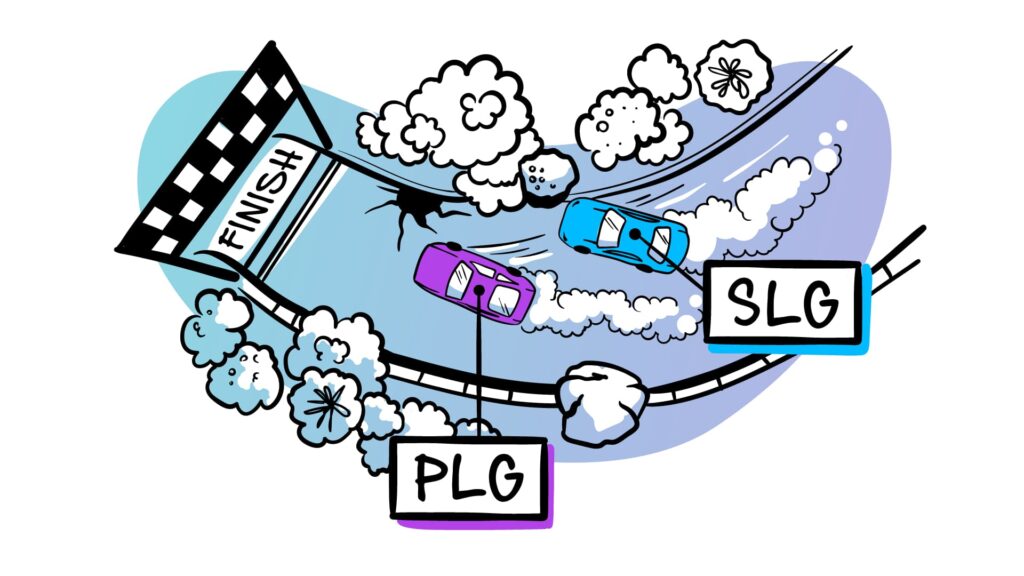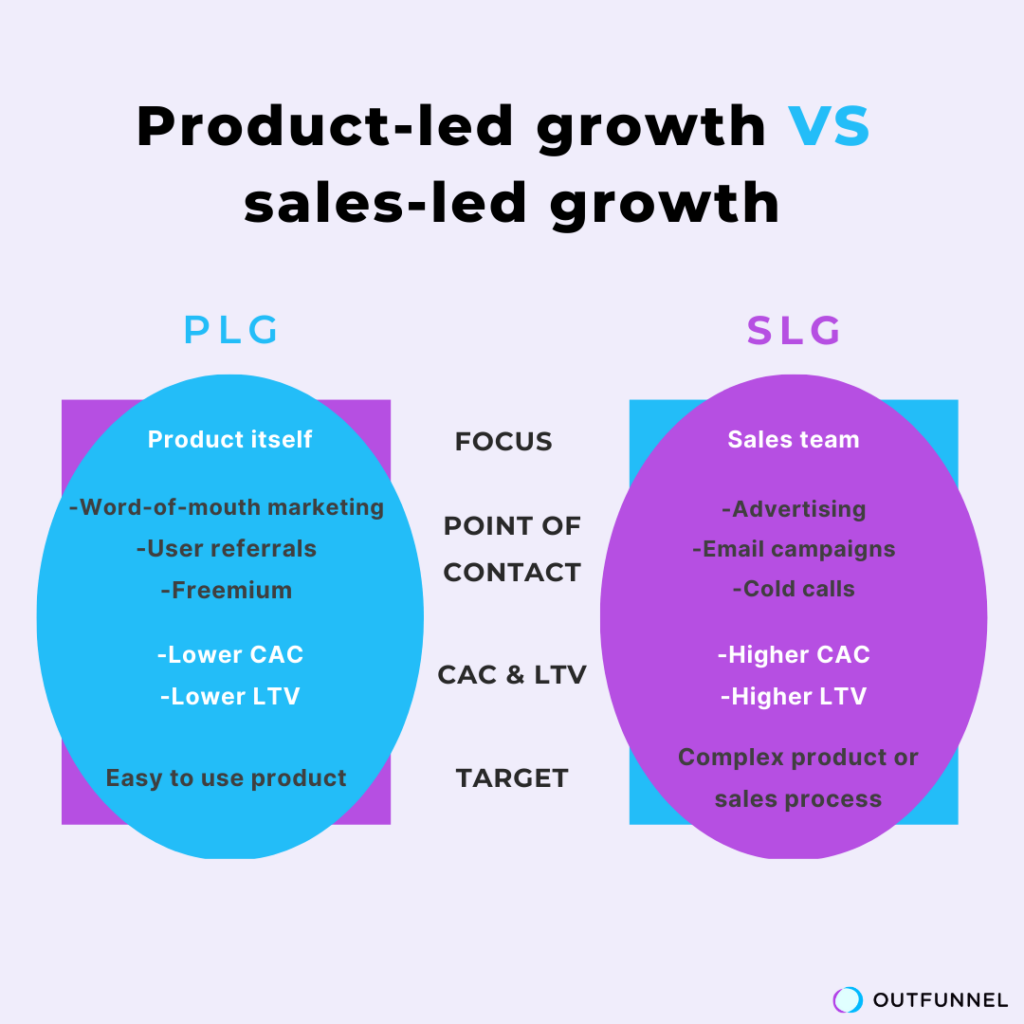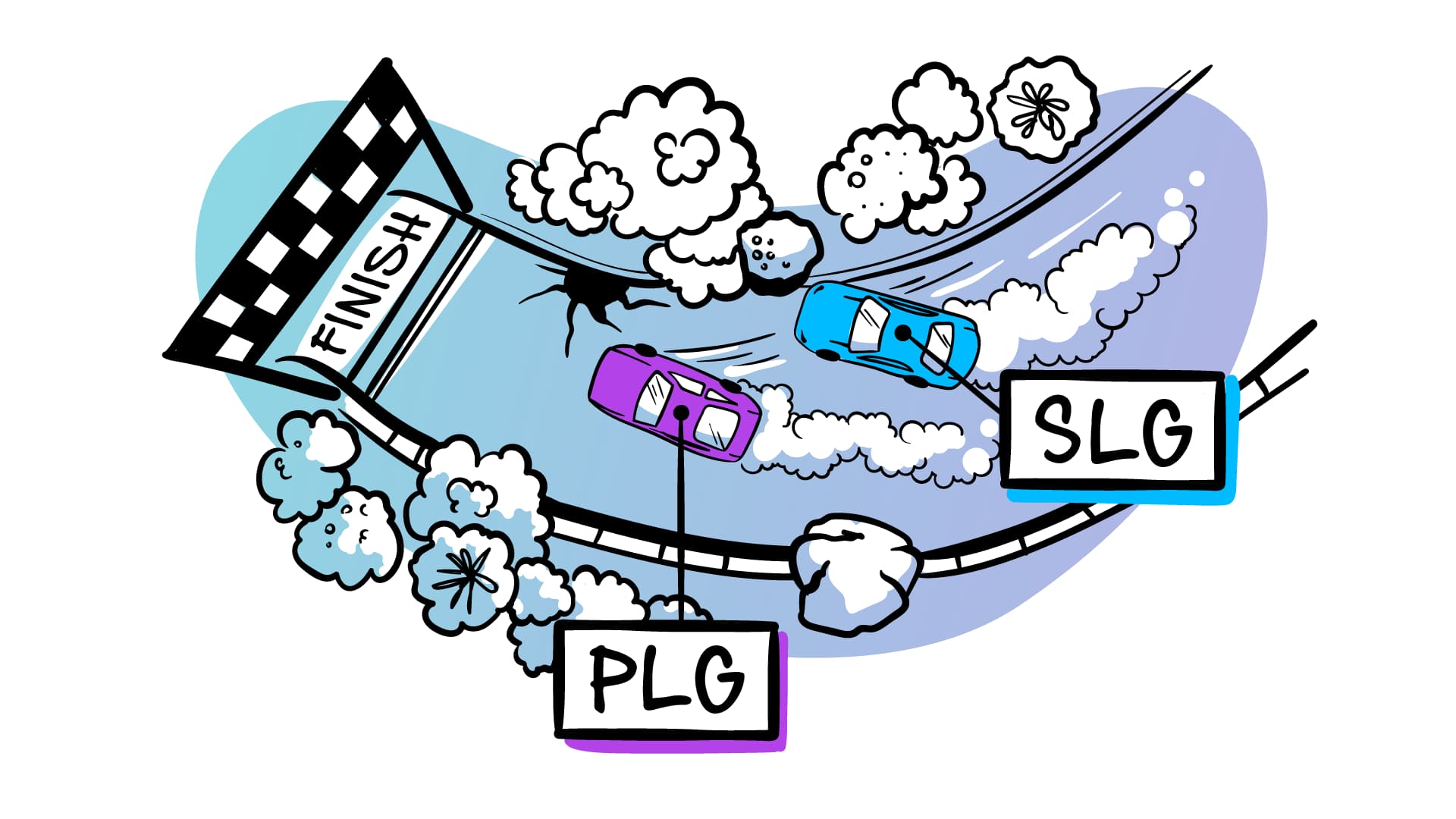Choosing between product-led growth (PLG) and sales-led growth (SLG) is a tough decision.
And before you can decide whether you should switch 100% to product-led growth or choose a hybrid approach, it’s important to understand the benefits of each strategy.
This is what we will discuss in this article — a detailed look at PLG vs SLG and whether you should start implementing PLG.
“Product-led growth is not a silver bullet. It requires a deep understanding of your customers, a relentless focus on user experience, and a commitment to continuous experimentation and improvement.”
Janna Bastow, Co-founder of ProdPad
TOPICS WE’LL COVER
- What is product-led growth?
- What is sales-led growth?
- The difference between product-led and sales-led growth
- Benefits of product-led growth
- Benefits of sales-led growth
- Cons of product-led growth
- Cons of sales-led growth
- PLG vs SLG: which one is right for you?
- How to easily get started with product-led growth?
Key takeaways:
- You don’t always have to choose between PLG and SLG — you can take a hybrid approach that encompasses both strategies.
- The more complex the product, the more personalized sales it needs.
- The choice between product-led growth and sales-led growth is determined by a range of factors specific to your business.
What is product-led growth?
Product-led growth is a business strategy that focuses on building a product that is so valuable and intuitive that it drives customer acquisition and retention on its own. It is a customer-centric approach that relies on the product itself to be the primary driver of growth, rather than relying on marketing, sales, or other traditional growth tactics.
In a product-led growth strategy, the product is designed with the customer in mind and is made to be easy to use, intuitive, and valuable. This leads to a positive user experience and word-of-mouth marketing, which can drive new customer acquisition.
“Product-led companies flip the traditional sales model on its head. Instead of helping buyers go through a long, drawn-out sales cycle, they give the buyer the “keys” to their product. The company, in turn, focuses on helping the buyer improve their life. Upgrading to a paid plan becomes a no-brainer.”
Wes Bush, the author of “Product-Led Growth: How to Build a Product That Sells Itself”
Product-led growth also emphasizes the importance of customer engagement and retention. By providing customers with a product that is continuously updated and improved based on their feedback, PLG prioritizes customer satisfaction and loyalty. This makes product-led growth a fundament for product-led sales.
Start your PLG journey with our product-led sales platform.
Deep integrations with Pipedrive and HubSpot
Dropbox is a good example of what companies can achieve with a PLG strategy. When Dropbox first launched, they faced tough competition from other cloud storage services such as Google Drive and Box. To stand out from the competition, Dropbox implemented a PLG strategy that allowed them to acquire and retain users without the need for traditional sales and marketing efforts.
Steps that Dropbox took to implement a PLG strategy include:
- Free Trial: Dropbox offered a free trial to users that allowed them to use the service and store a limited amount of data. This encouraged users to try out the service and experience its benefits without any upfront cost.
- Referral Program: Dropbox implemented a referral program that rewarded existing users with additional storage space when they referred new users to the service. This incentivized users to refer their friends and family and helped Dropbox acquire new users at a low cost.
- Seamless User Experience: Dropbox made it easy for users to install and use the service across multiple devices. This allowed users to seamlessly integrate Dropbox into their daily workflows, making it a natural choice for file sharing and storage.
These steps allowed Dropbox to grow rapidly without the need for traditional sales and marketing efforts. With a product-led approach, they were able to generate over $1 billion in revenue in only 8.3 years and became one of the most popular cloud storage services in the world.
What is sales-led growth?
Sales-led growth is a business strategy that focuses on generating revenue through aggressive sales and marketing tactics. In a sales-led growth model, the sales team is the primary driver of growth, with the main objective being to increase revenue by acquiring new customers and maximizing sales from existing customers.
Sales-led growth relies heavily on traditional sales and marketing tactics such as cold calling, advertising, and promotions to generate leads and drive sales. The focus is on convincing potential customers to buy the product or service, rather than relying on the product itself to drive growth.
This approach is often used in businesses with high-ticket items or complex products that require a significant investment from customers. In these cases, the sales team is crucial in educating customers on the product and addressing any objections or concerns they may have.
While sales-led growth can be effective in driving revenue, it may not necessarily lead to long-term customer loyalty or retention. Customer experience and satisfaction often take a backseat to hit revenue targets in a sales-led approach, which can make customers feel neglected or undervalued.
“The days of pushy sales tactics and cold calls are over. The future is about creating products that speak for themselves and enable customers to easily discover, try, and buy what they need.”
Dharmesh Shah, Co-founder and CTO of HubSpot

The difference between product-led and sales-led growth
Both PLG and SLG are growth strategies that help companies increase revenue, but there are crucial differences in how each approach achieves this. Let’s take a look at four areas where PLG and SLG part ways.
- Focus
Product-led growth is a strategy where the product itself is the primary driver of growth. In this approach, the focus is on blowing the customers away by creating a product that brings immense value to their lives and is intuitive to use.
Sales-led growth, on the other hand, is a strategy where the sales team is the primary driver of customer acquisition and growth. In this approach, the focus is on building a highly talented sales team that can find and close deals with new customers, upsell and cross-sell to existing customers, and drive revenue growth.
- Point of contact
PLG companies often rely on word-of-mouth marketing, user referrals, and freemium or free trial models to acquire and retain customers.
On the other hand, SLG companies use sales and marketing tactics such as cold calling, email campaigns, and advertising to reach potential customers and generate leads.
- Customer acquisition cost (CAC) & lifetime value (LTV)
PLG companies typically have lower customer acquisition costs and higher customer lifetime value. This makes sense if you think about it. Word-of-mouth marketing is essentially free, which reduces the CAC. Plus, since PLG companies often have products that improve the lives of their customers, you’re bound to have a high customer LTV.
SLG companies, on the other hand, often have higher customer acquisition costs and lower customer lifetime value, as they rely on sales and marketing tactics to acquire customers.
- Target
PLG is often favored by companies with a product that is inherently valuable and easy to use, such as consumer software and mobile apps.
Meanwhile, SLG is often favored by companies with a more complex product or sales process, such as enterprise solutions.

Benefits of product-led growth
Product-led growth has six important benefits for businesses, including:
- Easy customer acquisition: By building a product that is valuable and intuitive, businesses can attract new customers through word-of-mouth marketing and positive user experiences instead of having to rely on difficult strategies like cold calling.
- Higher customer retention: A product-led approach emphasizes customer engagement and feedback, leading to a better customer experience and higher retention rates.
- Increased customer lifetime value: By continuously improving the product based on customer feedback, businesses can increase customer satisfaction and loyalty, leading to higher customer lifetime value.
- Reduced customer acquisition costs: With a product-led approach, businesses can rely on the product to drive customer acquisition, reducing the need for costly marketing and advertising campaigns.
- Faster time to value: A product-led approach focuses on providing value to the customer as quickly as possible, leading to faster adoption rates and time to value for customers.
- Competitive advantage: Building a product that is easy to use, intuitive, and valuable can provide PLG companies a competitive advantage over businesses that rely solely on sales and marketing tactics.
Overall, product-led growth can lead to a more customer-centric approach, driving higher customer satisfaction and retention rates, reducing acquisition costs, and ultimately leading to sustainable business growth. To help you decide, here are 10 examples of the best product-led growth companies with takeaways and tips from the leaders.
Benefits of sales-led growth
It would be incorrect to say that sales-led growth comes without any benefits. Whether these benefits are relevant to your business is something for you to decide, but here are three of them you should be aware of:
- Ability to sell complex products: A sales-led approach can effectively sell complex products or services that require a more personalized sales approach.
- Control over revenue targets: Sales-led growth allows businesses to have more control over revenue targets, as the focus is on hitting sales targets and maximizing revenue.
- Clear ROI: Sales-led growth provides a clear return on investment (ROI) for marketing and sales activities. This can be difficult to determine for a PLG approach, as it’s difficult to calculate the cost of the many factors that go into improving customer experience and creating a valuable product.
Overall, sales-led growth can be an effective strategy for businesses looking to sell complex products and have more control over revenue targets. However, it may not lead to long-term customer loyalty or retention like PLG and can require significant investments in sales and marketing activities.
Cons of product-led growth
Product-led growth (PLG) strategy can be a very effective way to grow a business, but there are also potential drawbacks and challenges associated with this approach. Some of the cons of a PLG strategy include:
- Limited market reach: PLG strategies often rely on virality and word-of-mouth referrals to grow the user base. While this can be effective in certain markets, it may not work as well in others, especially if the product is targeted at a niche audience.
- Longer sales cycle: A PLG approach is often passive, as there are no sales efforts driving leads down the sales funnel., This can result in longer sales cycles, as it takes time for customers to really understand the value a product brings to their lives. This can be problematic for companies that need to generate revenue quickly or have limited resources.
- Revenue uncertainty: PLG strategies may not generate revenue in the short term, as companies may offer a free trial or freemium model to attract users. This can be challenging for companies that need to show revenue growth to investors.
- Limited customer insights: With a PLG approach, companies may have limited customer insights, as they rely on self-service onboarding and customer support. This can make it difficult to identify pain points and address customer needs.
- Product-centric focus: PLG strategies are primarily focused on the product, which can be a disadvantage if customer support and service are not prioritized. This can lead to poor customer experiences and low retention rates.
Cons of sales-led growth
Just like a product-led approach, a sales-led growth strategy comes with its own set of cons. Here are four of them you should know:
- High cost: Sales-led growth strategies can be expensive, as they require a significant investment in sales and marketing resources. This can be challenging for companies with limited budgets or those that need to show profitability quickly.
- Limited scalability: A sales-led growth strategy may not be as scalable as other approaches, as it requires a high level of investment in sales and marketing activities. This can limit growth potential over time.
- Lack of product focus: A sales-led approach may place less emphasis on the product, which can result in a poor user experience and low customer retention rates over time.
- Short-term focus: Sales-led growth strategies often prioritize short-term revenue growth over long-term customer value. This can result in a focus on quick sales wins rather than building sustainable customer relationships.
PLG vs SLG: which one is right for you?
Determining whether product-led growth or sales-led growth is the best strategy for your company depends on various factors, including your product, target market, and business goals.
A PLG strategy may be the most effective approach for you if you have a product that:
- Is easy to use
- Provides value to the customer quickly
- Targets young or tech-savvy individuals (as they are more likely to adopt new products and rely on word-of-mouth marketing)
On the other hand, you should consider an SLG approach if you have a product that:
- Is complex to use
- Requires a more personalized sales approach and onboarding
- Targets an old or tech-naive population

How to easily get started with product-led growth?
If you are still confused about whether a PLG approach is right for your business, we suggest you try the Outfunnel Product-Led Sales Platform free for 14 days. The platform identifies your product-qualified leads (PQLs), which allows your sales team to prioritize them and increase the lead-to-win conversion rates by 32%. Plus, exciting features like deep integration with Pipedrive and more are coming soon!



